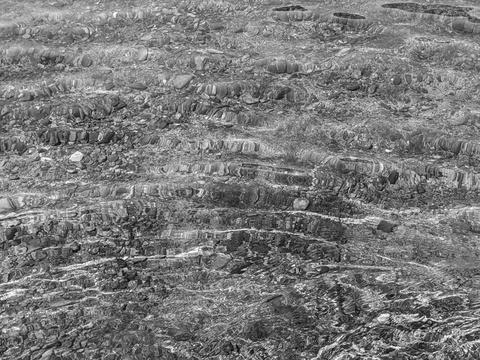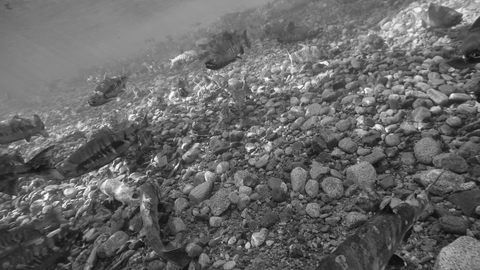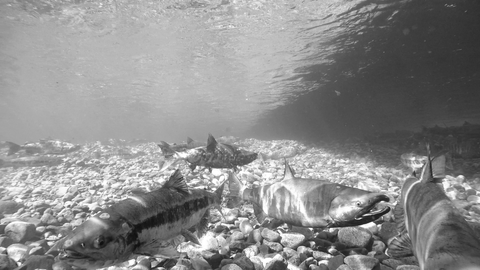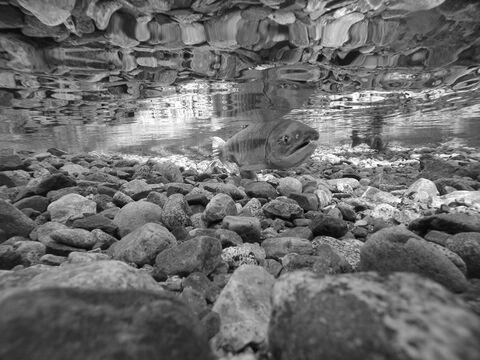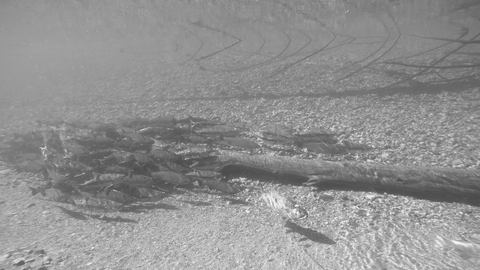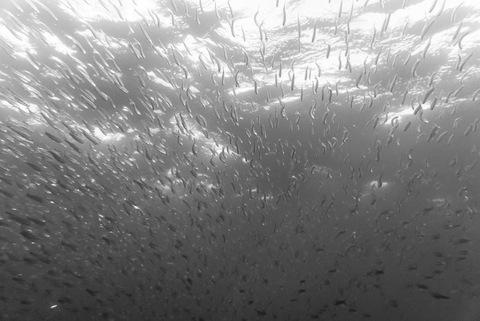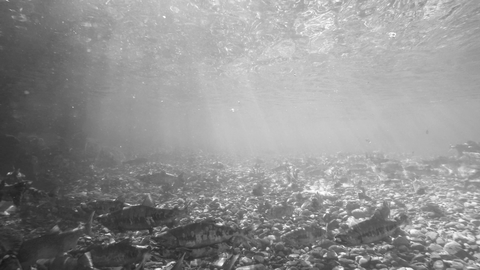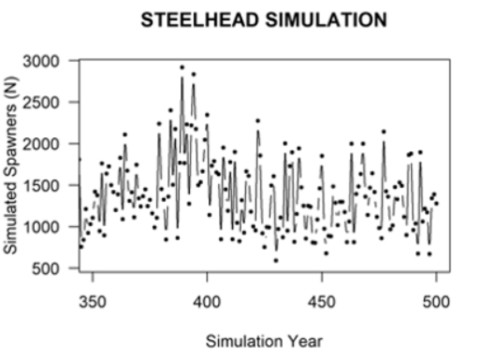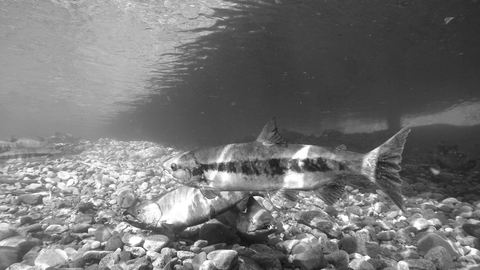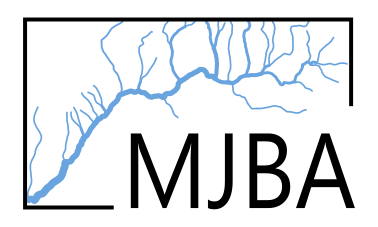Life Cycle Modelling
Overview
Life cycle models are analytical tools used to understand and predict the dynamics of a population over time. These models typically divide a population into different life stages, such as egg, alevin, fry, parr, smolt, juvenile, adult, spawner etc., and describe the rates of growth, reproduction, and mortality for each stage. By incorporating factors like age-specific survival rates, reproductive output, and environmental influences, life cycle models help ecologists and conservationists understand how populations change over time under different conditions. Life cycle models are commonly implemented to quantify trade-offs between scenarios and to characterize limiting factors..
When life cycle models are applied to stream restoration for a focal population, we can gain valuable insights about potential scenarios (as alternative futures) and effectiveness of various restoration strategies. Life cycle models help us to better understand limiting factors for a target population of interest. Here are some of the ways life cycle models can be instrumental to inform restoration strategies:
- Simulating Scenarios (alternative futures): Life cycle models simulate the effects of various ecological scenarios on a target population, such as changes in stream flow, water quality, and habitat structure/availability. By altering multiple input parameters, life cycle models predict how different restoration efforts (such as altering flow regimes, stream temperatures, and/or improving riparian habitat) might impact a given population. The key theme here is thinking about quantitative relationships, synthesis of information and trade-offs between scenario alternatives.
- Identifying Limiting Factors: Life cycle models help identify critical bottlenecks in the life cycle for a specific population. For example, if a population model reveals that fry survival rates are particularly low for a given system, this might indicate issues like inadequate instream habitat. Alternatively, low marine survival (e.g., low smolt adult return ratios) may indicate that a populations’ future will remain vulnerable, regardless of habitat restoration efforts in the freshwater environment.
- Assessing Cumulative Effects: Stream ecosystems are complex, and multiple factors often interact to govern the viability and productivity of a target population. Life cycle models can assess the cumulative impact of various factors, such as temperature, stream flows, and habitat availability, across different life stages. Cumulative effect assessments are also tightly coupled with scenario analysis using life cycle models. The goal of these exercises is not to “predict the future”, but instead to identify scenarios as sets of events that might reasonably take place and then identify pathways for achieving desired outcomes (WCEL, 2017). Life cycle models are introduced into cumulative effect assessments as a means to synthesize information.
- Long-term and Short-term Impacts: Life cycle models can project both immediate and long-term consequences of restoration activities. This helps in understanding how today's actions will influence future populations, which is crucial for sustainable management.
- Adaptive Management: By comparing actual ecological outcomes with model predictions, managers can refine their understanding of the ecosystem and improve restoration strategies. This iterative process is a core part of adaptive management in ecological restoration.
- Science Communication: Life cycle models can also be used as communication tools. They help explain complex ecological interactions to community participants.
In the context of stream restoration for Pacific salmon, life cycle models are vital for developing effective, evidence-based strategies that address the specific needs of a focal population.
Tools, Codebases and Frameworks
- HARP (Beechie et al 2021): Life cycle model of Pacific Salmon in Chehalis River linking key stressors to life cycle components which then modify survival, productivity etc. Resource link contains overview page with associated publications, data, and model code. HARP tool and codebase is hardwired (coded) for the Chehalis River, but concepts and themes are more broadly transferable.
- CEMPRA (2022): Similar to the HARP tool, the life cycle modelling component of the CEMPRA tool allows users to link stressors and stressor response relationships to components of a life cycle model. Stressors then modify the survival, capacity, or fecundity of a given life stage. Scenarios are run to explore changes to the overall capacity or productivity of a simulated population.
- DyHDER (Murphy 2020): Dynamic Habitat Disturbance and Ecological Resilience (DyHDER): modeling population responses to habitat condition. Spatially explicit, stage-structured matrix population model, with annual movement and transition probabilities. Model also includes stressor response relationships for a case study system with time-varying parameters.
- All-H Analyzer Tool (AHA): The All‐H Analyzer (AHA) tool is a Excel‐based application to evaluate management options relating to habitat, fish passage (through hydropower system), harvest and hatcheries. The calculator integrates components to estimate equilibrium natural escapement, brood stock requirements, and harvest for natural and hatchery-origin fish. See technical report(s) from the Hatchery Scientific Review Group (HSRG).
- ShinyPop: Quick and easy diagnostics for matrix population models. ShinyPop is a webapp that uses RShiny and the R packages popdemo and Rage to visualise population dynamics and life history parameters using matrix projection models (MPMs). MPMs may be specified by the user, otherwise ShinyPop connects to the COMPADRE and COMADRE MPM databases.
Key References and Case Studies for Pacific Salmon
- Spromberg, Julann A., and James P. Meador. "Relating chronic toxicity responses to population-level effects: A comparison of population-level parameters for three salmon species as a function of low-level toxicity." ecological modelling 199.3 (2006): 240-252.
- Lessard, R. B., Hilborn, R., & Chasco, B. E. (2008). Escapement goal analysis and stock reconstruction of sockeye salmon populations (Oncorhynchus nerka) using life-history models. Canadian Journal of Fisheries and Aquatic Sciences, 65(10), 2269-2278.
- Leppi, J. C., Rinella, D. J., Wilson, R. R., & Loya, W. M. (2014). Linking climate change projections for an Alaskan watershed to future coho salmon production. Global change biology, 20(6), 1808-1820.
- Araujo, H. A., Cooper, A. B., MacIsaac, E. A., Knowler, D., & Velez-Espino, A. (2015). Modeling population responses of Chinook and coho salmon to suspended sediment using a life history approach. Theoretical population biology, 103, 71-83.
- Davison, R. J., & Satterthwaite, W. H. (2016). Use of age‐and stage‐structured matrix models to predict life history schedules for semelparous populations. Natural Resource Modeling, 29(4), 538-558.
- Gayeski, N., Pess, G., & Beechie, T. (2016). A life-table model estimation of the parr capacity of a late 19th century Puget Sound steelhead population. FACETS, 1(1), 83-104.
- Scheer, G. (2017). A population model for Coho salmon (Onchorhynchus kisutch) in freshwater creek: evaluating the effects of life history variation and habitat restoration.
- Beechie, T. J., C. Nicol, C. Fogel, J. Jorgensen, J. Thompson, G. Seixas, J. Chamberlin, J. Hall, B. Timpane-Padgham, P. Kiffney, S. Kubo, and J. Keaton. 2021. Modeling Effects of Habitat Change and Restoration Alternatives on Salmon in the Chehalis River Basin Using a Salmonid Life-Cycle Model. U.S. Department of Commerce, NOAA Contract Report NMFS-NWFSC-CR-2021-01.
- Beechie, T. J., C. Nicol, C. Fogel, J. Jorgensen, and B. Timpane-Padgham. 2021. Chum Salmon Life-Cycle Model Description and Results for the Chehalis River Basin. U.S. Department of Commerce, NOAA Contract Report NMFS-NWFSC-CR-2021-02
- Crozier, L. G., Burke, B. J., Chasco, B. E., Widener, D. L., & Zabel, R. W. (2021). Climate change threatens Chinook salmon throughout their life cycle. Communications biology, 4(1), 222.
- Gibeau, P., & Palen, W. J. (2021). Impacts of run‐of‐river hydropower on coho salmon (Oncorhynchus kisutch): the role of density‐dependent survival. Ecosphere, 12(8), e03684.
- Jorgensen, J. C., Nicol, C., Fogel, C., & Beechie, T. J. (2021). Identifying the potential of anadromous salmonid habitat restoration with life cycle models. PLoS One, 16(9), e0256792.
- Sorel, M. (2022). Informing salmon conservation with population models that account for individual heterogeneity (Doctoral dissertation, University of Washington).
- Bellmore, J. R., Sergeant, C. J., Bellmore, R. A., Falke, J. A., & Fellman, J. B. (2022). Modeling coho salmon (Oncorhynchus kisutch) population response to streamflow and water temperature extremes. Canadian Journal of Fisheries and Aquatic Sciences, 80(2), 243-260.
- Kendall, N. W., Unrein, J., Volk, C., Beauchamp, D. A., Fresh, K. L., & Quinn, T. P. (2023). Life Cycle Model Reveals Sensitive Life Stages and Evaluates Recovery Options for a Dwindling Pacific Salmon Population. North American Journal of Fisheries Management, 43(1), 203-230.
